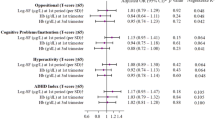Summary
This study was embedded within the Generation R, a population-based birth cohort in the Netherlands where children were followed up from birth until young adulthood. Of the 4997 eligible mother-child pairs with data on maternal thyroid levels (excluding twins), 3873 pairs of children and caregivers (77.5%) were included in the main analyses. Maternal hypothyroxinemia, characterized by low levels of free thyroxine coexisting with reference thyrotropin levels, and children’s symptoms of attention-deficit hyperactivity disorder (ADHD) were the main outcome measures. Maternal thyroid hormone levels (thyrotropin, free thyroxine, thyroid peroxidase antibodies) were measured at a mean (SD) of 13.6 (1.9) weeks of gestation. Children’s ADHD symptoms were assessed at 8 years of age using the Conners’ Parent Rating Scale-Revised Short Form; higher scores indicate more ADHD symptoms (possible range, 0–36). Maternal hypothyroxinemia (n=127) in early pregnancy was associated with higher scores for ADHD symptoms in children at 8 years of age after adjustments for child and maternal factors (increase in ADHD scores, 7% [95% CI, 0.3%, 15%]). The results remained essentially unchanged when women with elevated levels of thyroid peroxidase antibodies were excluded. The authors concluded that children exposed to maternal hypothyroxinemia in early pregnancy had more ADHD symptoms, independent of confounders. This finding suggests that intrauterine exposure to insufficient thyroid hormone levels influences neurodevelopment in offspring.
Similar content being viewed by others
References
Modesto T, Tiemeier H, Peeters RP, Jaddoe VW, Hofman A, Verhulst FC, et al. Maternal mild thyroid hormone insufficiency in early pregnancy and attention-deficit/ hyperactivity disorder symptoms in children. JAMA Pediatr. 2015 Jul 6. [Epub ahead of print.
Critical Appraisal Skills Programme. 12 questions to help you make sense of cohort study. Available from: http:// media.wix.com/ugd/dded87_e37a4ab637fe46a0869f9f 977dacf134.pdf. Accessed August 14, 2015.
STROBE statement. STrengthening the Reporting of OBservational studies in Epidemiology. Available form: http://www.strobe-statement.org/ Accessed August 14, 2015.
STROBE Statement—Checklist of items that should be included in reports of cohort studies. Available from: http://www.strobe-statement.org/fileadmin/Strobe/uploads/ checklists/STROBE_checklist_v4_cohort.pdf. Accessed August 14, 2015.
No authors listed. The Bradford Hill Criteria. Available from: http://www.southalabama.edu/coe/bset/johnson/ bonus/Ch11/Causality%20criteria.pdf. Accessed August 14, 2015.
References
Conners CK. Conners Parent Rating Scales–Revised short version (CPRS-R:S). New York 1997, Multi-Health systems Inc.
Ghassabian A, El Marroun H, Peeters RP, Jaddoe VW, Hofman A, Verhulst FC, et al. Downstream effects of maternal hypothyroxinemia in early pregnancy: nonverbal IQand brain morphology in school-age children. J Clin Endocrinol Metab. 2014;99:2383–90.
Roman GC, Ghassabian A, Bongers-Schokking JJ, Jaddoe VWV, Hofman A, de Rijke YB, et al. Association of gestational maternal hypothyroxinemia and increased autism risk. Ann Neurol. 2013;74:733–42.
Pop VJ, Brouwers EP, Vader HL, Vulsma T, van Baar AL, de Vijlder JJ. Maternal hypothyroxinemia during early pregnancy and subsequent child development: A 3-year follow up study. Clin Endocrinol. 2003;59:282–8.
References
Glinoer D, Delange F. The potential repercussions of maternal, fetal, and neonatal hypothyroxinemia on the progeny. Thyroid. 2000;10:871–87.
Elahi S, Nagra SA. Low maternal iodine intake and early pregnancy hypothyroxinemia: Possible repercussions for children. Indian J Endocrinol Metab. 2014;18:526–30.
Henrichs J, Ghassabian A, Peeters RP, Tiemeier H. Maternal hypothyroxinemia and effects on cognitive functioning in childhood: how and why? Clin Endocrinol. 2013;79:152–62.
Furnica RM, Lazarus JH, Gruson D, Daumerie C. Update on a new controversy in endocrinology: isolated maternal hypothyroxinemia. J Endocrinol Invest. 2015;38:117–23.
Negro R, Soldin OP, Obregon M-J, Stagnaro-Green A. Hypothyroxinemia and pregnancy. Endocr Pract. 2011;17:422–9.
Kooistra L, Crawford S, van Baar AL, Brouwers EP, Pop VJ. Neonatal effects of maternal hypothyroxinemia during early pregnancy. Pediatrics. 2006;117:161–7.
Author information
Authors and Affiliations
Corresponding authors
Rights and permissions
About this article
Cite this article
Mathew, J.L., Mukherjee, S.B., Sukumar, S.P. et al. Maternal mild thyroid insufficiency and risk of attention deficit hyperactivity disorder. Indian Pediatr 52, 797–801 (2015). https://doi.org/10.1007/s13312-015-0720-0
Published:
Issue Date:
DOI: https://doi.org/10.1007/s13312-015-0720-0




